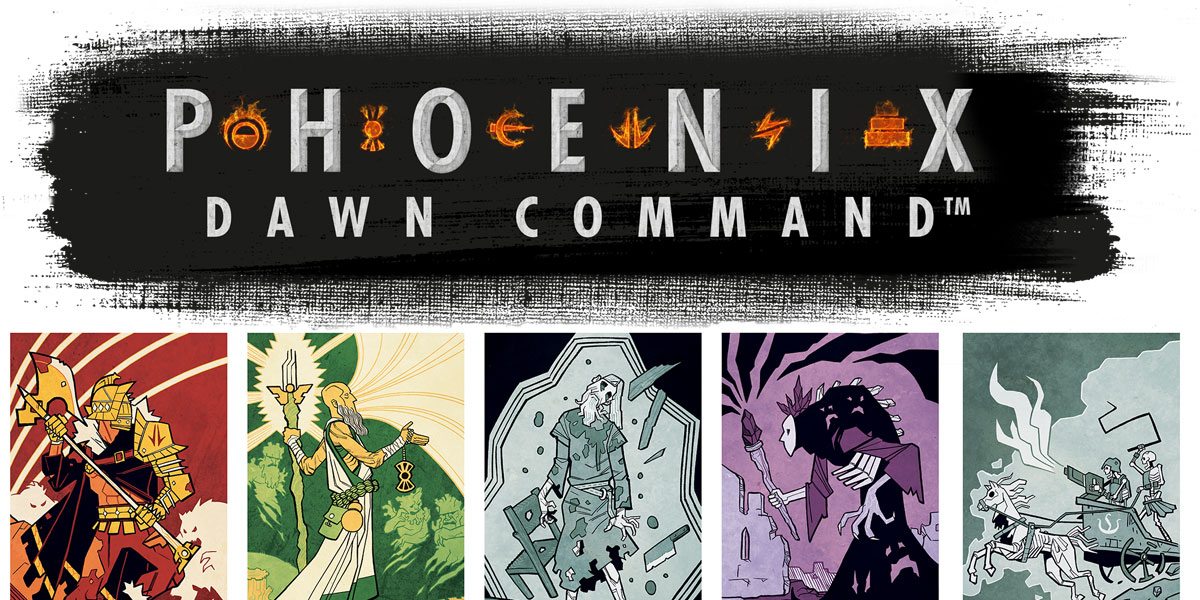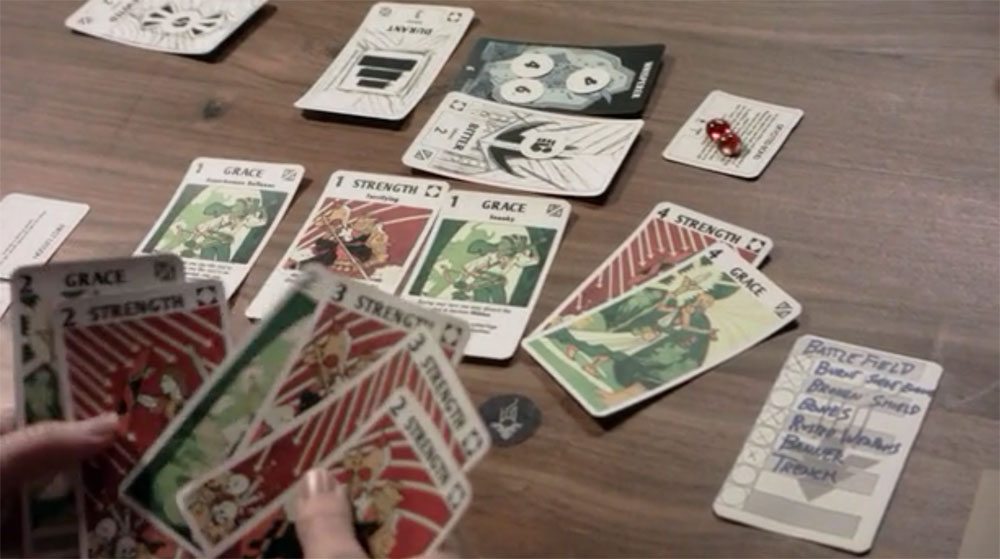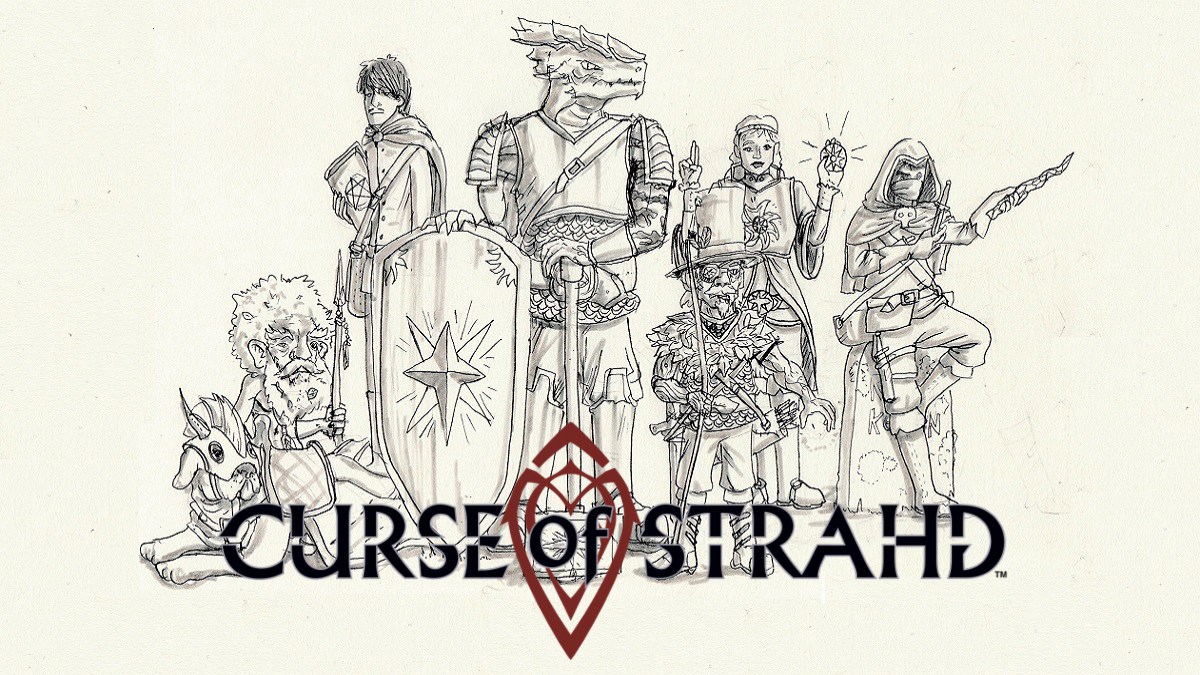In Phoenix: Dawn Command, that which kills you makes you stronger. Keith Baker’s new card-driven role-playing game is set in a world where each death adds to and helps define your powers. But your rebirths are numbered, so make the most of them before your time is truly over.
At a glance: Phoenix: Dawn Command is a role-playing game for two to six players plus a gamemaster, ages 13 and up. (The game will include enough cards for four players plus the GM, but you could go up to 6 with additional cards.) It’s currently on Kickstarter, and a pledge level of $50 (plus shipping outside of the US) gets you a copy of the game. Like other RPGs, the GM can adjust the game to account for different player ages, but this is a game about death, rebirth, sacrifice, and scary supernatural threats, so use your best judgment on that.
New to Kickstarter? Check out our crowdfunding primer.
Components
- Phoenix: Dawn Command book
- 280 Tarot-sized cards (Action cards, Lessons, School cards and Challenges)
- 32 Health tokens
- 70 Spark tokens
- Condition tokens
With any RPG, the most significant component is the book: the rules that explain how the game works, the world that the game is set in, and so forth. Phoenix: Dawn Command will include more about the world of the Phoenixes and also has seven pre-built missions, plus information for GMs to develop their own stories.
The game uses cards instead of dice–more on that below. I’ve gotten to see some of the card samples, and I really like the look of them. They’re Tarot-sized, so they’re large and have plenty of room to display the text without crowding the artwork, by Rich Ellis and Grace Allison. Unlike most fantasy games I’ve seen, Phoenix uses a stylized graphic look rather than photorealistic paintings, and I like it a lot.

The player’s Action cards have different types like Grace, Strength, or Intellect, as well as a value from 1 to 5. Some of these cards have Traits–for example, “Superhuman Reflexes” or “Never Give Up.” These have a value of 1, but can be increased if you can explain to the GM how you’re using that trait in a particular challenge.
How It Works
Now, since this is an RPG and I usually write up board games, I’ll take a somewhat different approach.
In the world of Phoenix, there are people who can return after death with incredible powers. They go through a process in the Crucible, and their powers are tied to the reason they died. Each time they die, they increase in rank and grow in power–but after the seventh time, death is permanent.
The plotline of the game is tied to the Dread, a blight that started three years ago. A multitude of supernatural creatures have appeared, spreading across the Empire and wreaking havoc. As a Phoenix, you and your team face off against this mysterious enemy in a series of missions.
When you first begin a game, you create a character–like other RPGs. In Phoenix, you will choose one of the seven Schools, linked to the way you died:
- Devoted: you died for somebody else, and are now a healer.
- Durant: you died because you weren’t strong enough, and now you are a strong defender.
- Elemental: you died for duty; now you can burn your own life force to unleash attacks of fire and storm.
- Forceful: you died because you weren’t fast enough; now you are the fastest of the Phoenixes.
- Shrouded: you died because of a secret, and now you work from the shadows and uncover the hidden.
- Bitter: you died as a failure, and now you draw strength from injury.
The character sheet you fill out is more story-driven than numbers-based, and the GM can draw from these answers during a mission to give the players more of a connection to the story.
Players then draft Action cards for their decks, and each of the Schools has two suits that apply to them, signifying the two primary ways they deal with problems. You also get Lesson cards, which are displayed in front of you at all times–these represent your skills and abilities, your Combat Style, and so forth.
You get a pool of Spark tokens, which represent a mystical energy. These may be spent to increase the value of an Attack or Skill, and are also sometimes spent to activate particular abilities. You do regain Sparks each dawn, but if you run out of them, you die.
You also have some health tokens: they flip over to become wounds. If you run out of health, you also die, though you can still hang around in spirit form if you have Sparks left.
Phoenix doesn’t use dice, but instead uses these cards. When you are attempting something difficult (something that would normally require rolling dice for a check), you make a spread of Action cards, either for Attack, Defense, or a Skill. The Combat Style you selected for the turn determines which suits you can use for Attack and Defense, and the GM determines which suits can be used for any particular Skill check.
You make a spread and total up the value. Sparks can increase the value, and so can Traits if you can explain how they’re tied to what you’re doing. For Attacks and Defense, the damage done is the difference between the total value of the spread and the total value of the enemy’s defense or attack. For a Skill spread, there are various tiers based on the total value, from failure to competent to legendary.
Because of the way the game works, there is some luck in what cards you draw each turn, but not in the outcome of an action. From the cards in your hand, you’ll know what values you have available to you, whether you’ll have enough attack to do damage or enough of a skill to succeed at a check.
The Verdict
Phoenix: Dawn Command was designed by Keith Baker (famous for Gloom and the D&D Eberron campaign setting) and Dan Garrison (an experienced GM who hasn’t had any commercially published games yet). I met Keith Baker a couple years ago during the Kickstarter campaign for The Doom That Came to Atlantic City, and have gotten to know him and his wife Jenn Ellis (the other half of Twogether Studios). So, although I’m not too experienced with RPGs and definitely don’t feel ready to GM a game on my own yet, I was curious to find out more about Phoenix when Keith first told me about the idea.
What I have found over the past couple years is that there are aspects of RPGs that I really enjoy: playing with the same group of people consistently, creating a character and seeing it level up and gain new skills, working cooperatively with other players to overcome tough challenges, and seeing the story unfold as we play through many adventures together. What I’m not so good at is the actual role-playing part of it: staying in character, coming up with my character’s back story … heck, I even have trouble coming up with a name. And my current life as a stay-at-home dad and games reviewer doesn’t always allow for a lot of long sessions playing the same thing. (The Pathfinder Adventure Card Game is my lone exception.) So I’ve had limited success working RPGs into my life, but I’ve tried out a few different systems and have generally enjoyed them–I just haven’t had the benefit of a long-term campaign yet.
I did get to play one session of Phoenix with Keith and a few other friends; we spent some time creating our characters, drafting a set of cards, and then playing through one sample mission. Keith was our GM and walked us through it all. This was with an earlier ruleset so I know there have been tweaks and adjustments since I played, primarily to make the math a little simpler and more intuitive.
First: I really like the setting. The core idea of Phoenix came from Dan Garrison, during a campaign in which he killed off Keith’s character. For GMs, there’s a balance between making an adventure interesting for your players and making it so hard that they actually die. You don’t want it to be boring, but if you make a challenge too difficult and kill off players, that gets unpleasant, too. But the stories we love are filled with characters who die–sometimes for very important reasons–and so the idea was born to make death an integral part of the game. It’s an odd concept at first, leveling up by dying, but it’s very cool. The hard limit on rebirth keeps you from just throwing yourself into a pit repeatedly, though. You’ve only got seven lives, so you have to make them count.
The cards were also an interesting aspect to the game. I liked the idea of being able to choose how to use my cards and knowing whether I had enough in my hand to succeed. Instead of a lucky or unlucky roll, the outcome depended more on how much I was willing to put into each action–and whether my teammates wanted to spend Sparks to help. Using Traits to boost an action is also fun, and it really encourages more of a storytelling aspect–you don’t just say “I’m taking this action,” but you describe it in a way that incorporates the Trait.
I did have a little trouble filling out the character sheet while creating a character, because I’m not used to thinking in terms of my character’s motivation and history. But I did appreciate the exercise, and the way that Keith was able to work in details from our characters’ pasts into the story. Of course, that takes a good GM. If your character dies, then you’ll also gain new Lessons as you go through the Crucible and prepare for the next rebirth. Your School doesn’t change, but depending on how you died, you might get a Lesson from a different School, giving you a range of skills.
On the spectrum from board game (mechanics-focused) to RPG (storytelling-focused), Phoenix is certainly on the RPG end. For comparison, I would put Pathfinder Adventure Game and Shadows of Brimstone closer to the board game end, where you can put in storytelling if you like but you could just play them by the mechanics if you wanted.
All in all, I found Phoenix: Dawn Command pretty fascinating and I’ve enjoyed watching it develop. If you’re looking for an RPG with a twist and a very cool premise, check out the Kickstarter campaign for more. They’ll be releasing more information about the gameplay as the campaign continues, and you can also read more about it at the Twogether Studios website.






